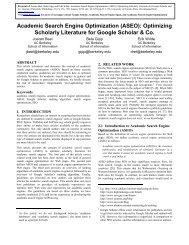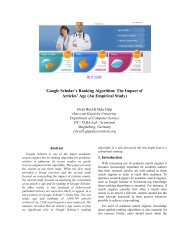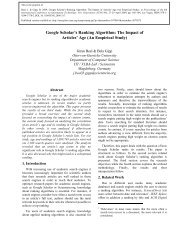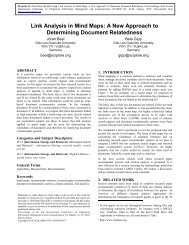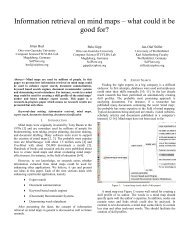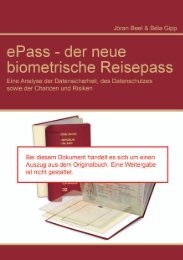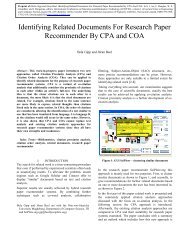Google Scholar's Ranking Algorithm: The Impact of ... - Bela Gipp
Google Scholar's Ranking Algorithm: The Impact of ... - Bela Gipp
Google Scholar's Ranking Algorithm: The Impact of ... - Bela Gipp
Create successful ePaper yourself
Turn your PDF publications into a flip-book with our unique Google optimized e-Paper software.
Citation Count (Ordinal)Citation Count (Ordinal)importance for webmasters to be listed in one <strong>of</strong> the very firstpositions and that ranking algorithms significantly influences theamount <strong>of</strong> visitors a webpage receives. It seems likely that thesame is basically true for academic search engines.250200150100500Search Term: "Dell"0 250 500 750 1000Position in Result ListFigure 1: Pattern I<strong>The</strong> second point <strong>of</strong> criticism relates to the fact that citationmeasures impact but not quality in general [3, 4]. That means,articles with many citation counts are not always „good‟. It mightmake sense to rank articles with high citation counts first if a useris searching for standard literature with high impact. But theremay be situations in which it makes no sense to display highlycited papers in the first positions. This could be, for instance, ifsomeone searches for the latest trends in a certain research field orarticles from authors advancing a view different from themajority.350300250200150100500Search Term: "Progress"0 250 500 750 1000Position in Result ListFigure 2: Pattern IIAs mentioned, most academic databases <strong>of</strong>fer differentapproaches for ranking publications and users can select one <strong>of</strong>them. <strong>Google</strong> Scholar is one <strong>of</strong> the few academic search enginescombining several approaches in a single algorithm 2 . Severalstudies about <strong>Google</strong> Scholar exist. Studies include, for instance,research into data overlap with other academic search enginessuch as Scopus and Web <strong>of</strong> Science [5], [6], <strong>Google</strong> Scholar‟scoverage <strong>of</strong> the literature in general and in certain research fields[7], [8], the suitability to use <strong>Google</strong> Scholar‟s citation counts forcalculating bibliometric indices such as the h-index [9] and thereliability <strong>of</strong> <strong>Google</strong> Scholar as a serious information source ingeneral [10], [11]. <strong>Google</strong> Scholar itself publishes only vagueinformation about its ranking algorithm: <strong>Google</strong> Scholar sorts“articles the way researchers do, weighing the full text <strong>of</strong> eacharticle, the author, the publication in which the article appears,and how <strong>of</strong>ten the piece has been cited in other scholarlyliterature” [12]. Any other details or further explanation is notavailable.Although <strong>Google</strong> Scholar‟s ranking algorithm has a significantinfluence on which academic articles are read by the scientificcommunity, we could not find any studies about <strong>Google</strong> Scholar‟sranking algorithm despite our own one [13]. From our previousstudy we know that:<strong>Google</strong> Scholar‟s ranking algorithm puts a high weighton words occurring in the title.<strong>Google</strong> Scholar considers only those words that aredirectly included in an article and does not considersynonyms <strong>of</strong> those words.<strong>The</strong> frequency in which query terms occur in the fulltext seems to have little to no impact on <strong>Google</strong>Scholar‟s rankings. That means that an article will notbe ranked higher for a certain search just because thesearch term occurs frequently in the full text.<strong>Google</strong> Scholar is not indexing text embedded viaimages.<strong>Google</strong> Scholar uses different ranking algorithms for akeyword search in the full text, keyword search in thetitle, the „related articles‟ function and the „cited by‟function.<strong>Google</strong> Scholar‟s ranking algorithm puts a high weighton author and journal names.<strong>Google</strong> Scholar seems to weight recent articles strongerthan older articles in order to compensate for theMatthew effect.<strong>The</strong> most confusing finding from our previous research was abouthow <strong>Google</strong> Scholar weighs citation counts. We found out that ingeneral, <strong>Google</strong> Scholar weighs an article‟s citation count heavily.However, different patterns were discovered (see Figure 1 andFigure 2) and we could not explain why these patterns occurred orif further patterns existed.3. RESEARCH OBJECTIVEOur previous study indicated a strong interrelationship between anarticle‟s citation count and its position in <strong>Google</strong> Scholar. <strong>The</strong>research objective <strong>of</strong> the current study was to confirm or reject theprevious results based on a larger sample size and to researchwhether further patterns exist about how rankings interrelate withcitation counts.Since <strong>Google</strong> Scholar <strong>of</strong>fers two search modes (search in title andsearch in full text), and our previous study indicated that differentranking algorithms are applied, we also researched whethercitation counts have a different weight when searching in the titlerather than searching the full text.2 Others are, for instance, CiteSeer and Scienstein.org [15, 3]
Number <strong>of</strong> Query TermsCitation CountNumber <strong>of</strong> Query Terms4. METHODOLOGY<strong>Google</strong> Scholar displays for each article its citation count in theresults list. To obtain citation counts for a significant number <strong>of</strong>papers, we developed a Java program to parse <strong>Google</strong> Scholar 3 .This program sends search queries to <strong>Google</strong> Scholar and storesthe citation counts and positions <strong>of</strong> all returned results in a .csvfile. Due to <strong>Google</strong> Scholar‟s limitations, only a maximum <strong>of</strong>1,000 results per search query was retrievable. <strong>The</strong> parsingprocess was performed twice, each time with 1,050 search querieswhere 1,050 search queries consisted <strong>of</strong> 350 single-word searchqueries, 350 double-word search queries and 350 triple-wordsearch queries 4 . In the first run, search terms were searched in thefull text. In the second run, search terms were searched in the title.From 1,050 full text searches, all search queries returned morethan 50 results (see Table 1) and could be used for the analysis.From 1,050 title searches, 511 returned either zero or one resultand were not considered for further analysis (see Table 2). Thiswas caused by the way search queries were created. <strong>The</strong>y werecreated automatically by combining different words from a wordlist which resulted in some senseless search queries such as „finishfather‟ or „excessive royalty‟. While sufficient documentationexists in which, for instance, the words „finish‟ and „father‟ occursomewhere in the full text, no documents exist which includethese words in the title.Table 1: Amount <strong>of</strong> Search Results by Number <strong>of</strong> QueryTerms (Full Text Search)SingleWordsDoubleWordsTripleWordsTotalNumber <strong>of</strong> Search Results[0,1] [2, 10] [11, 50] [51, 250] [251, 1000] [1001, 10000] [10001, *]Absolute 0 0 0 0 0 2 348Relative 0.0% 0.0% 0.0% 0.0% 0.0% 0.6% 99.4%Absolute 0 0 0 0 3 24 323Relative 0.0% 0.0% 0.0% 0.0% 0.9% 6.9% 92.3%Absolute 0 0 0 1 4 86 259Relative 0.0% 0.0% 0.0% 0.3% 1.1% 24.6% 74.0%Absolute 0 0 0 1 7 112 930Relative 0.0% 0.0% 0.0% 0.1% 0.7% 10.7% 88.6%Overall, data from 1,561 search queries (1,050 searches in the fulltext and 511 searches in the title) was used for further analysis.<strong>The</strong> 1,561 search queries returned a total <strong>of</strong> 1,364,757 results(1,032,766 articles for full text searches and 331,991 articles fortitle searches). <strong>The</strong> articles' citation counts and rankings werestored and analyzed. To verify correct execution <strong>of</strong> the <strong>Google</strong>Scholar parser, spot checks were performed.Table 2: Amount <strong>of</strong> Search Results by Number <strong>of</strong> QueryTerms (Title Search)SingleWordsDoubleWordsTripleWordsTotalNumber <strong>of</strong> Search Results[0,1] [2, 10] [11, 50] [51, 250] [251, 1000] [1001, 10000] [10001, *]Absolute 0 1 1 12 23 102 211Relative 0.0% 0.3% 0.3% 3.4% 6.6% 29.1% 60.3%Absolute 166 89 54 27 11 3 0Relative 47.4% 25.4% 15.4% 7.7% 3.1% 0.9% 0.0%Absolute 345 5 0 0 0 0 0Relative 98.6% 1.4% 0.0% 0.0% 0.0% 0.0% 0.0%Absolute 511 95 55 39 34 105 211Relative 48.7% 9.0% 5.2% 3.7% 3.2% 10.0% 20.1%To identify interrelationships between citation counts andpositions, the distribution <strong>of</strong> citation counts on the first and lastpositions were analyzed. This aimed to recognize whether articleswith high/low citation counts occur more/less <strong>of</strong>ten in high/lowpositions. In addition, all results <strong>of</strong> the search queries werevisualized to recognize patterns. This was performed for originalcitation counts and citation counts transformed to an ordinal scale.<strong>The</strong> transformation was performed for the results <strong>of</strong> each searchquery as follows: <strong>The</strong> lowest citation count was replaced with 0,the second lowest with 1 and so on (see Table 3).<strong>The</strong> transformation was performed to ease the visualizationprocess. Differences between graphs based on original and ordinalcitation counts are illustrated in Figure 3 and Figure 4. Bytransforming citation counts the data‟s meaning changes slightly.In contrast to absolute citation counts, an ordinal citation count<strong>of</strong>, "5" means that his paper has the fifth lowest citation count <strong>of</strong>those articles in the result set. All graphs in this paper are basedon ordinal data if not stated otherwise. Overall, a total <strong>of</strong> 3,122graphs were created and inspected individually (1,561 graphsdisplaying original citation counts, and 1,561 graphs displayingordinal citation counts).Table 3: Transformation <strong>of</strong> Citation CountsOriginal DataResult 1 Result 2 Result 3 Result 4 …Query 1 593 18 5 5Query 2 485 6932 311 298…Transformed Data (Ordinal)Result 1 Result 2 Result 3 Result 4 …Query 1 3 2 1 1Query 2 3 4 2 1…1600014000120001000080006000400020000Search Term: "Physics"0 250 500 750 1000Position in Result ListFigure 3: Visualization <strong>of</strong> Original Citation Counts3 All data was collected in November 20084 <strong>The</strong> words for creating the search queries were extracted from anacademic word list [16]
Citation Counts (Ordinal)Citation Count (Ordinal)Citation Count (Ordinal)Search Term: "Physics"60050040030020010000 250 500 750 1000Position in Result ListFigure 4: Visualization <strong>of</strong> Ordinal Citation Counts5.2 Graphs <strong>of</strong> the MeansFigure 5 illustrates the mean citation count per position forsearches in the full text. It is clearly recognizable that a strongrelationship exists between an article‟s citation count and itsposition. What stands out is the increase <strong>of</strong> the mean citationcounts in the later positions. At first glance, it seems likely thatoutliers distort the citation counts <strong>of</strong> the last positions. In ourdataset the mean citation count for position 1,000 was calculatedfrom only 88 numbers 5 . By contrast, the mean citation count forposition 1 was calculated from 1,050 numbers. <strong>The</strong>refore, few buthigh outliers could have distorted the calculation. However,further analysis revealed that not only mean, but also mediancitation counts are significantly higher on the very last positionsthan in the positions before.120100Mean5. RESULTS & INTERPRETATION5.1 Citation Count DistributionIn Table 4 the distribution <strong>of</strong> articles‟ citation counts incomparison to their ranking in <strong>Google</strong> Scholar is listed forsearches in the full text. 23.3% <strong>of</strong> all analyzed articles had zerocitations, but only 14.7% <strong>of</strong> those articles ranked in position 1 to10 had zero citations and only 10.8% <strong>of</strong> those articles in position1. If citation counts do not impact the ranking, one would expectaround 23% <strong>of</strong> zero-cited articles in a first position. In contrast,16.7% <strong>of</strong> the articles ranked in position 1 had more than 1,000citations, although these types <strong>of</strong> articles made up only 0.8% <strong>of</strong>the total articles. Overall, the data clearly shows that citationcounts do have a significant impact on articles‟ ranking.Table 4: Articles’ Citation Count Distribution (Full Text)Citation Count0 [1, 3] [4, 10] [11, 50] [51, 150] [151, 500] [501, 1000] [1001, *]Position 1 10.8% 3.8% 7.6% 19.2% 15.6% 17.7% 8.6% 16.7%Top 10 14.7% 8.0% 9.0% 18.6% 15.9% 17.2% 7.2% 9.4%Total 23.3% 14.7% 14.9% 24.1% 13.0% 7.6% 1.6% 0.8%<strong>The</strong> same analysis for title searches is presented in Table 5.Interestingly, 10.6% <strong>of</strong> the top 10 articles have zero citationsalthough only 7.5% <strong>of</strong> all articles had zero citations. <strong>The</strong> reasonfor this became clear after examining the raw data. <strong>The</strong> searchqueries were created automatically by combining different wordsfrom a word list and some senseless search queries such as „finishfather‟ or „excessive royalty‟ emerged. <strong>The</strong>refore, 57.7% <strong>of</strong> the1,050 search queries delivered only 10 or less results, and many <strong>of</strong>these results had few citations (see Table 2). If only articles inwhich search queries with more than 100 results are considered,the data would look similar to the data from Table 4. Additionally,24.3% <strong>of</strong> those articles ranked in position 1 had more than 1,000citations, although this type <strong>of</strong> article makes up only 0.7% <strong>of</strong> thetotal articles. Overall, the data confirms that citation counts have adefinite and significant impact on an article‟s ranking. Differencesbetween title and full text searches seem less significant.Table 5: Articles’ Citation Count Distribution (Title)Citation Count0 [1, 3] [4, 10] [11, 50] [51, 150] [151, 500] [501, 1000] [1001, *]Position 1 4.6% 9.6% 6.9% 11.5% 10.9% 19.3% 12.8% 24.3%Top 10 10.6% 8.2% 6.3% 11.2% 15.4% 22.7% 10.9% 14.7%Total 7.5% 15.9% 15.0% 28.0% 20.0% 11.2% 1.8% 0.7%8060402000 250 500 750 1000Position in <strong>Google</strong> ScholarFigure 5: Mean Citation Counts (Full Text Search)120100806040200Mean0 250 500 750 1000Position in <strong>Google</strong> ScholarFigure 6: Mean Citation Counts (Title Search)5 <strong>The</strong>re are two reasons for the low sample size <strong>of</strong> the lastpositions. First, not all search queries delivered 1000 results.Second, <strong>Google</strong> Scholar <strong>of</strong>ten displays slightly less than 1000results even if there are 1000 or more results in its database.
Citation Count (Ordinal)Citation Counts (Ordinal)Citation Count (Ordinal)160140Mean (Single Search Terms)250Search Term: "Dell"1201008020015060402000 250 500 750 1000Position in <strong>Google</strong> ScholarFigure 7: Mean Citation Counts (Title Search, Single Words)<strong>The</strong> graph for title searches (see Figure 6) draws a similar picture.Only the lower mean citation counts in the first positions standout. A closer examination explains this. For searches in the titlewith search queries consisting <strong>of</strong> two or three search terms, manyresults with few citation counts were returned by <strong>Google</strong> Scholar(see Table 2 and Table 5). This small sample size pushes themeans in the first positions downwards. When search queries withless than 50 results are ignored, the search in the title presents asimilar graph as the search in the full text. This is shown in Figure7, which displays the means for the title search with single- wordqueries only.Overall, all graphs show an almost perfect interrrelationshipbetween an article‟s citation count and its position in <strong>Google</strong>Scholar. It could be assumed that other factors play either a minorrole or none at all in <strong>Google</strong> Scholar‟s ranking algorithm.However, it stands out that the mean citation counts in the lastpositions significantely increase. We have no explanation for thisphenomenon.5.3 Graphs <strong>of</strong> Individual Search Queries<strong>The</strong> graphs <strong>of</strong> the mean citation counts show a very clearinterrelationship between an article‟s citation count and the way itis ranked by <strong>Google</strong> Scholar. However, in our previous study wediscovered various patterns for individual search queries thatdiffer from the graph <strong>of</strong> mean citation counts. <strong>The</strong>refore, weanalyzed the graphs <strong>of</strong> all individual search queries anddiscovered six different graph types.5.3.1 Standard GraphThis type <strong>of</strong> graph (see Figure 8) looks as one would expect fromwhat the research indicated so far: A strong interrelationshipexists between a paper‟s citation count and its position in <strong>Google</strong>Scholar. As observed previously, the last positions <strong>of</strong>ten show acomparatively high citation count. Additionally, some significantoutliers exist.1005000 250 500 750 1000Position in Result ListFigure 8: Standard Graph5.3.2 Weak Standard GraphThis type <strong>of</strong> graph is similar to the standard graph, but correlationbetween citation counts and positions appears weaker (see Figure9). <strong>The</strong> existence <strong>of</strong> this type <strong>of</strong> graph indicates that there areother important factors determining the position <strong>of</strong> an article in<strong>Google</strong> Scholar‟s results list.5.3.3 No PatternThis type <strong>of</strong> graph indicates no interrelationship <strong>of</strong> a paper‟scitation count and its position in <strong>Google</strong> Scholar at all (see Figure10). It completely contradicts the overall observation that highercitation counts lead to a better ranking. We could not find anyexplanation <strong>of</strong> why this type <strong>of</strong> graph occurs. Apparently there aresituations in which citation counts have no impact.450400350300250200150100500Search Term: "Childhood"0 250 500 750 1000Position in Result ListFigure 9: Weak Standard Graph
Here, further research is required as well as for the weight <strong>of</strong> otherfactors such as the age (upcoming paper see [14]).In the final analysis, due to the strong weight on citation counts,<strong>Google</strong> Scholar is more suited when searching for popularstandard literature than for searching gems, the latest trends, orpapers whose authors are advancing views opposite to themainstream. This is neither good nor bad, but users should beaware <strong>of</strong> it. <strong>Google</strong> Scholar also strengthens the Matthew Effect:articles with many citations will be more likely displayed in a topposition, get more readers and receive more citations, which thenconsolidate their lead over articles which are cited less <strong>of</strong>ten. If<strong>Google</strong> Scholar should become only partly as popular forscientific articles as it is for web pages, there would be an evenhigher incentive for researchers to influence their article‟s citationcounts; for instance via self citations or citation alliances.7. REMARKWe would be delighted to share the <strong>Google</strong> Scholar parsers<strong>of</strong>tware, including gathered data, with other researchers whowish to perform their own research or evaluate ours. Please sendus an email if you are interested in the data or the s<strong>of</strong>tware.8. ACKNOWLEDGEMENTSOur thanks go to Ammar Shaker for supporting the development<strong>of</strong> the <strong>Google</strong> Scholar parser. In addition we have to thank Dr.Wolfgang Lehmann for his advice. We regret that we had not thetime to consider all <strong>of</strong> his feedback.9. REFERENCES[1] R. K. Merton, “<strong>The</strong> Matthew Effect in Science,” Science, vol.159, no. 3810, pp. 56–63, January 1968.[2] (2006, August) Click Through Rate <strong>of</strong> <strong>Google</strong> Search Results- AOL-data.tgz - Want to Know How Many Clicks <strong>The</strong> no.1<strong>Google</strong> Position Gets? Red Cardinal Blog. Red Cardinal Ltd.[3] J. Beel and B. <strong>Gipp</strong>, “<strong>The</strong> Potential <strong>of</strong> CollaborativeDocument Evaluation for Science,” in 11th InternationalConference on Digital Asian Libraries (ICADL'08), ser. LectureNotes in Computer Science (LNCS), G. Buchanan,M. Masoodian, and S. J. Cunningham, Eds., vol. 5362.Heidelberg (Germany): Springer, December 2008, pp. 375–378.[4] J. Beel and B. <strong>Gipp</strong>, “Collaborative Document Evaluation: AnAlternative Approach to Classic Peer Review,” in 5thInternational Conference on Digital Libraries (ICDL'08), ser.Proceedings <strong>of</strong> World Academy <strong>of</strong> Science, Engineering andTechnology, vol. 31, August 2008, pp. 410–413.[5] J. Bailey, C. Zhang, D. Budgen, M. Turner, and S. Charters,“Search Engine Overlaps : Do they agree or disagree?” in SecondInternational Workshop on Realising Evidence-Based S<strong>of</strong>twareEngineering (REBSE '07), 2007, p. 2.[6] K. Yang and L. I. Meho, “Citation Analysis: A Comparison <strong>of</strong><strong>Google</strong> Scholar, Scopus, and Web <strong>of</strong> Science,” in 69th AnnualMeeting <strong>of</strong> the American Society for Information Science andTechnology, Austin (US), 2006, pp. 3–8.[7] W. H. Walters, “<strong>Google</strong> Scholar coverage <strong>of</strong> amultidisciplinary field,” Information Processing & Management,vol. 43, no. 4, pp. 1121–1132, July 2007.[8] J. J. Meier and T. W. Conkling, “<strong>Google</strong> Scholar‟s Coverage<strong>of</strong> the Engineering Literature: An Empirical Study,” <strong>The</strong> Journal<strong>of</strong> Academic Librarianship, vol. 34, no. 34, pp. 196–201, 2008.[9] J. Bar-Ilan, “Which h-index? - A comparison <strong>of</strong> WoS, Scopusand <strong>Google</strong> Scholar,” Scientometrics, vol. 74, no. 2, pp. 257–271,2007.[10] P. Jacso, “<strong>Google</strong> Scholar: the pros and the cons,” OnlineInformation Review, vol. 29, no. 2, pp. 208–214, 2005.[11] B. White, “Examining the claims <strong>of</strong> <strong>Google</strong> Scholar as aserious information source,” New Zealand Library & InformationManagement Journal, vol. 50, no. 1, pp. 11–24, 2006.[12] (2008) About <strong>Google</strong> Scholar. Website. <strong>Google</strong> Inc.[Online].Available:http://scholar.google.com/intl/en/scholar/about.html[13] J. Beel and B. <strong>Gipp</strong>, “<strong>Google</strong> <strong>Scholar's</strong> <strong>Ranking</strong> <strong>Algorithm</strong>:An Introductory Overview (Research in Progress),” to bepublished, 2009.[14] J. Beel and B. <strong>Gipp</strong>, “<strong>Google</strong> <strong>Scholar's</strong> <strong>Ranking</strong> <strong>Algorithm</strong>:<strong>The</strong> <strong>Impact</strong> <strong>of</strong> Articles' Age (An Empirical Study),” inProceedings <strong>of</strong> 6th International Conference on InformationTechnology : New Generations (ITNG'09). IEEE, 2009.[15] B. <strong>Gipp</strong> and J. Beel, “Scienstein: A Research PaperRecommender System,” in International Conference on EmergingTrends in Computing. IEEE, 2009, pp. 309–315.[16] S. Haywood. (2008) <strong>The</strong> Academic Word List. University <strong>of</strong>Nottingham. [Online]. Available:http://www.nottingham.ac.uk/ alzsh3/acvocab/wordlists.htm



